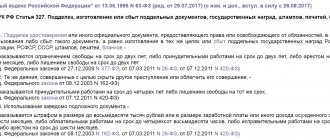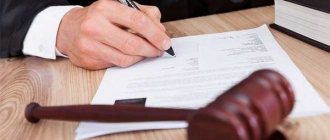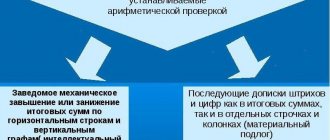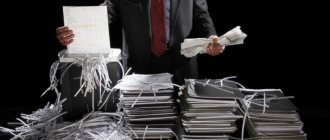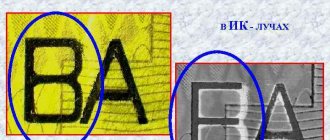Criminal Code of the Russian Federation in the latest edition:
Article 327.1 of the Criminal Code of the Russian Federation. Production, sale of counterfeit tax stamps, special stamps or marks of conformity or their use
1. Manufacturing for the purpose of marketing or selling counterfeit excise stamps, special stamps or marks of conformity protected from counterfeiting (except for excise stamps and federal special stamps for marking alcoholic products, as well as special (excise) stamps for marking tobacco products), -
shall be punishable by a fine in the amount of one hundred thousand to three hundred thousand rubles, or in the amount of the wages or other income of the convicted person for a period of one to two years, or by forced labor for a term of up to three years, or by imprisonment for the same term.
2. Use of knowingly counterfeit excise stamps, special stamps or marks of conformity protected from counterfeiting (with the exception of excise stamps and federal special stamps for marking alcoholic products, as well as special (excise) stamps for marking tobacco products), -
shall be punishable by a fine in the amount of one hundred thousand to five hundred thousand rubles, or in the amount of the wages or other income of the convicted person for a period of one to three years, or by forced labor for a term of up to five years, or by imprisonment for the same term.
3. Manufacturing for the purpose of marketing or selling counterfeit excise stamps or federal special stamps for marking alcoholic products or counterfeit special (excise) stamps for marking tobacco products -
shall be punishable by a fine in the amount of three hundred thousand to five hundred thousand rubles, or in the amount of the wages or other income of the convicted person for a period of one to two years, or by forced labor for a term of up to five years, or by imprisonment for a term of up to eight years with a fine in the amount of from seven hundred thousand to one million rubles or in the amount of wages or other income of the convicted person for a period of up to five years or without it.
4. The use of obviously counterfeit excise stamps or federal special stamps for labeling alcoholic products, as well as the use of knowingly counterfeit special (excise) stamps for labeling tobacco products -
shall be punishable by a fine in the amount of three hundred thousand to five hundred thousand rubles, or in the amount of the wages or other income of the convicted person for a period of one to two years, or by forced labor for a term of up to five years, or by imprisonment for a term of up to eight years with a fine in the amount of from seven hundred thousand to one million rubles or in the amount of wages or other income of the convicted person for a period of up to five years or without it.
5. Actions provided for in part three of this article:
a) causing major damage to the state or involving the extraction of large-scale income;
b) committed by a group of persons by prior conspiracy or by an organized group, -
shall be punishable by a fine in the amount of five hundred thousand to eight hundred thousand rubles, or in the amount of the wages or other income of the convicted person for a period of three to five years, or by forced labor for a term of up to five years, or by imprisonment for a term of up to twelve years with a fine in the amount of seven hundred thousand to one million rubles or in the amount of wages or other income of the convicted person for a period of three to five years or without it and with or without restriction of freedom for a term of up to one year.
6. Actions provided for in part four of this article:
a) causing major damage to the state or involving the extraction of large-scale income;
b) committed by a group of persons by prior conspiracy or by an organized group, -
shall be punishable by a fine in the amount of seven hundred thousand to one million rubles, or in the amount of the wages or other income of the convicted person for a period of three to five years, or by forced labor for a term of up to five years, or by imprisonment for a term of up to twelve years with a fine in the amount of seven hundred thousand to one million rubles or in the amount of wages or other income of the convicted person for a period of three to five years or without it and with or without restriction of freedom for a term of up to one year.
Note. In this article, major damage or large-scale income means damage or income in an amount exceeding one hundred thousand rubles.
Return to the table of contents of the document: Criminal Code of the Russian Federation in the latest edition
About document flow in the Russian Federation
Document flow is the movement of official documents. It is tracked from the moment the document is created until the moment it is executed and transferred to the archive. There are several types of documents:
- incoming – those that come from other organizations;
- outgoing – those that are sent to other organizations;
- internal - those that are created in the organization and used by its employees.
What an official document is is not explained in the legislation of the Russian Federation. But based on the ruling of the Constitutional Court of the Russian Federation No. 1677-О-О dated December 16, 2010, the official document has two features:
- it was published by an official entity or provided to him;
- the document has the ability to represent, i.e. it may confer rights or impose duties on the person who uses it.
Please note that all documents included in the document flow of commercial organizations are not official. Agreements concluded between individuals are not considered official documents.
What are fake documents
Forgery of documents in the Criminal Code of the Russian Federation is regarded as a serious crime. But first you need to decide what is considered falsification of documents.
In accordance with the comments to Article 327 of the Criminal Code of the Russian Federation, forgery is understood as an illegal change in any official document: self-correction or change of data, re-taping photos, etc. Part of a document, for example, a passport photo, or the entire document can be forged.
The official documents that are most often forged are:
- identification documents;
- education diplomas;
- certificates of incapacity for work;
- driver's licenses;
- powers of attorney certified by a notary;
- service certificates;
- military tickets;
- certificates of a war or labor veteran;
- pensions.
But it is worth noting that the production of false documents is not yet a reason for prosecution. According to the article for forgery of documents, it is a crime to produce false official documents for the purpose of selling or providing knowingly false documents for gain.
Types of document forgery
There are several types and methods of document forgery. By appearance, they distinguish between complete and partial forgery of official papers.
A complete forgery is when a document or form is completely falsified, from details to seals and signatures. The methods for complete counterfeiting are as follows:
- production of a document or form using special equipment;
- entering data that is knowingly false;
- falsification of an authenticating signature;
- forgery of a seal, imprint and/or stamp.
Partial falsification is when certain sections, for example, details, are changed in an original document. Methods of partial counterfeiting are:
- mechanical removal of part of the text;
- introducing new phrases, words or signs;
- removing document text using chemicals or solvents;
- re-sticking photographs;
- replacement of some parts of the original document.
How to detect a partial fake
Complete falsification of documents is extremely rare. As a rule, we are talking about a high quality counterfeit, which only a professional can recognize. Such papers are produced using professional equipment. Therefore, differences from the originals arise due to imperfect technologies, the use of other materials, etc.
Partial forgery is much more common. Here the changes may be minor, suggesting additional printing of words or even letters. We will talk about the most common methods of partial counterfeiting below.
Erasing
Erasure is the mechanical removal of graphic characters present on documents. The distinctive features of such an intervention are:
- disruption of the background grid;
- change in the surface layer of paper (especially noticeable on gloss), ruffled fibers);
- reducing paper thickness in areas of erasure;
- remnants of dye in the locations of the eliminated text;
- the smudged ink of the new text that was applied over the erasure.
Often, in order to disguise the erased area of the document, it is smoothed with a hard object. The lines of the background grid can be drawn on. In this case, the erasure can be detected by examining the document in oblique, diffuse, transmitted light or infrared rays. It is also possible to recognize a fake by using magnifying glasses and a microscope, which can reveal fiber breaks.
To restore the original text, a specialist can photograph invisible areas with filters in oblique light. It is also possible to use the diffuse-copy method.
Etching
This is the effect on printing ink through chemical reagents. To falsify documents in this way, various oxidizing agents, acids, and alkalis are used. As a result, the dye is either washed off or discolored. Chemical reagents have an effect not only on the text. The paper also suffers - changes are made to the background grid and other important details of the document.
The main signs of etching include:
- disappearance of gloss;
- the paper becomes rough;
- the shade of the sheet changes (borders and colored spots appear in places of etching);
- The color of the background grid changes;
- due to the violation of the paper sizing, the strokes of the new text become blurry;
- partial discoloration of records occurs because they are exposed to an etching substance that is partially preserved in the thickness of the paper;
- the sheet becomes brittle and fragile, tears and cracks may form on it;
- When viewed under ultraviolet rays, the luminescence of areas with etched text is noticeable.
To detect the presence of chemical etching, optical magnifying devices, oblique lighting, light filters, ultraviolet luminescence photography, etc. are used.
If dissolution was carried out by washing away, then barely visible remnants of the original text will be present on this section of paper. In this case, their general coloring is observed.
To restore etched text, the document is photographed in the infrared and ultraviolet zones of the spectrum.
Additional printing and addition
Reprinting is the addition of new characters, words or part of typewritten text. Adding is adding characters, letters, words or parts of text manually. In most cases, such changes are small in scope, but they can significantly distort the meaning of the original text. Most often, by adding numbers or words, the amounts in statements, receipts and invoices are changed. Last names, dates of paperwork, etc. can also be falsified.
The addition can be identified by the following signs:
- the symmetry of the text is broken;
- general and specific features of handwriting in the compared parts of the text are different;
- the possibility of blurriness of those strokes that were made along the folds of the document, differences in color shades, etc.
You can identify an overprint by the following signs:
- differences in defects in the mechanism and font are noticeable if additional printing was done using another typewriter;
- the horizontal position of printed characters in a line does not match;
- when examined under ultraviolet rays, different luminescence of signs in original and pre-printed details is noticeable;
- difference in the design and size of identical printed characters, differences in the color of the ribbon dye.
It is more difficult to detect a fake if the text was printed on the same machine. Then the experts check the intensity of the dye in the strokes, the matches between the lines of the main and pre-printed text, etc.
Have a question for a lawyer? Ask now, call and get a free consultation from leading lawyers in your city. We will answer your questions quickly and try to help with your specific case.
Telephone in Moscow and the Moscow region: +7
Phone in St. Petersburg and Leningrad region: +7
Free hotline throughout Russia: 8 (800) 301-39-20
Text correction
We are talking about partial changes in documents by converting some characters into others. You can recognize a correction by thickened strokes, double lines, and the presence of extra elements that remain from the previous sign. In some cases, these elements are erased, which entails the appearance of signs of erasure.
To identify text corrections, additional printing and additions, specialists use light filters, magnifying devices, and examine the chemical composition of dyes through chromatography and spectral analysis.
Replacing parts of a document
This type of forgery is used in ID cards. We are talking about passports, military IDs, work books. The following signs indicate a fake:
- the page numbering is incorrect;
- in places where sheets are fastened, the integrity of the paper layer is damaged;
- discrepancy between the number and series of the document, differences in page sizes;
- different luminescence of dye and paper;
- In the text fragments there is a noticeable discrepancy between the methods and types of printing.
The most common way to replace part of a document is to re-stick a photo card. The photograph is changed in passports, driver's licenses, etc. Replacement can be done either entirely or with the removal of the emulsion layer. When a photo is pasted in, the missing parts of the metal or mastic seal are added using pressure or additional drawing.
The following evidence indicates that the photograph has been pasted together:
- discrepancy between the letters of the text in the seal imprint and the document paper (different design, size of letters);
- peeling of the surface layer is observed at the edges of the paper;
- the photo card is pasted with an offset;
- two different types of glue were found under the photo;
- non-standard size, scale violations, etc.
Some documents are modified by pasting in fragments of the same papers. Such actions are performed with the aim of changing the number or series. We are talking about counterfeiting bonds, lottery tickets, and securities.
You can identify a fake by the following signs:
- unevenness of fiber disintegration and sheet thickness;
- differences in color and shade;
- there are traces of glue along the edges of the insert;
- There is a noticeable discrepancy between the lines of the background grid.
To identify a fake, a microscope and a UV lamp are used.
Forgery of signatures
Most often, criminals copy signatures from documents or resort to graphic copying technology. However, the most experienced fraudsters are capable of technical counterfeiting. It is performed in the following ways:
- squeezing;
- use of carbon paper;
- wet copying;
- using a printer;
- redrawing in the light.
Squeezing, redrawing against the light and using carbon paper are the simplest methods of counterfeiting. They are similar to each other and involve a repetition of the lines with which the original was made. You can detect such a fake by using a magnifying glass with low magnification. You should pay attention to the following signs:
- the presence of strokes of copy paper;
- kinks, tortuosity of individual strokes, underdrawing, unjustified stops of the writing medium;
- depressed strokes not covered with dye;
- traces of preliminary pencil preparation, if the forgery was made by copying against the light.
Wet copying technology involves transferring the dye of a genuine signature onto a fake document. For this, a special sticky material is used. It is pressed against a document with a genuine signature, after which the mirror image is copied onto the forged document.
Such a fake can be recognized by examining the signature under a microscope. In this case, changes in the structure are observed: unclear edges, low intensity of the dye, etc. If the signature was additionally circled, then traces of two dyes can be seen on the paper.
Corpus delicti
The corpus delicti under Article 327 of the Criminal Code of the Russian Federation is formal. The crime is considered completed when the production of false documents is completed. Responsibility for forgery of documents arises only if the citizen realizes that he is breaking the law, and the purpose of making a counterfeit is to use it for personal gain.
The object of the crime is the normal activities of government bodies and government authorities, as well as the interests and rights of legal entities and individuals.
The subjective side is the direct intent and purpose of selling or using a deliberately false document.
The subject of the crime is a sane citizen aged 16 years or older.
Second commentary to Art. 327 of the Criminal Code of the Russian Federation
1. The subjects of this crime - see: comments to Articles 324 and 325 of the Criminal Code. Form - a sheet of paper and/or an electronic template with text reflecting information of a management nature: details of the subject of management (another authorized subject), registration marks in the office management system.
Paper forms and electronic form templates must be identical in the composition of the details, the order of their arrangement, and font typefaces.
In management relations, a certificate is an official document confirming the powers of an official (the position he holds).
*"GOST R 7.0.97-2016. National standard of the Russian Federation. System of standards on information, librarianship and publishing. Organizational and administrative documentation. Requirements for the preparation of documents" (approved by Order of Rosstandart dated December 8, 2016 No. 2004-st).
*See, for example: Regulations on the official identification of federal civil servants and employees of the Federal Antimonopoly Service of Russia: approved. By Order of the Federal Antimonopoly Service of Russia dated July 5, 2010 No. 384.
The term “certificate” also refers to documents of a non-official nature: award certificate, certificate of a WWII participant, etc. The classification of a non-official certificate as a subject of crimes under Article 327 of the Criminal Code depends on its content and legal significance. For example, an award certificate is classified by law as “award material”1 and is an element of a state award. Therefore, its production or counterfeiting is the production or counterfeiting of a state award and should be qualified under Part 1 of Article 327 of the Criminal Code (and not under Part 2 of this article). Collectibles (faleristics) - orders, medals, badges, tokens, etc., made 50 years ago or more (with the exception of personal awards, for the wearing of which there are order books or award certificates) do not belong to the items of crimes provided for in Article 327 of the Criminal Code. . These objects are material carriers of cultural values, and not of management order.
2. Article 327 of the Criminal Code provides for four main elements of crime, which differ by type of act and subject of crime. Part 1 of Article 327 of the Criminal Code of the Russian Federation provides for the main elements of forgery, production or sale of official documents, state awards, seals, and forms. Part 2 of this article provides for liability for counterfeiting or selling a passport of a citizen of the Russian Federation or a certificate granting rights and exempting from duties. The norm provided for in part 2 of Article 327 of the Criminal Code is special in relation to the norm provided for in part 1 of this article.
Part 3 of Article 327 of the Criminal Code provides for the main characteristics of the circulation of counterfeit documents, state awards, stamps, seals or forms.
Part 4 of this article contains characteristics of the qualified elements of the first three types of crimes. A sign of increasing their punishability is the goal of hiding traces of a crime or facilitating its commission.
Part 5 of Article 327 of the Criminal Code provides for the main elements of using a forged document that does not belong to the category of official documents.
3. The objective side of the crime provided for in Part 1 of Article 327 of the Criminal Code includes alternative signs of acts in relation to various objects of management activity: forgery (production) or sale of official documents, state awards of the Russian Federation, RSFSR, USSR, stamps, seals and forms. Forgery of a document is the production of a completely falsified document or falsification of the details of a genuine document, the introduction of knowingly false information, corrections into the text of a document, falsification of signatures or other details of a document, etc. The production of state awards of the Russian Federation, the RSFSR, the USSR, stamps, seals and forms has the same meaning as counterfeiting - the complete production of an item or its alteration to give it the appearance of authenticity. Sales – transfer to other persons for permanent or temporary use.
4. The subjective side of this crime includes the direct intent and purpose of using the corresponding subject of the crime. The presence of this goal is determined not only by the personal interest of the perpetrator, but also by the awareness that the items manufactured (forged) by him will be used by other persons.
5. The subject of the crime provided for in Part 1 of Article 327 of the Criminal Code is a person who has reached the age of 16 years.
6. The objective and subjective aspects of the crime provided for in Part 2 of Article 327 of the Criminal Code include the same features as in Part 1 of this article. Distinctive features are special objects of the crime (passport of a citizen of the Russian Federation or a certificate granting rights and exempting from duties (see: commentary 6 to Article 325 and commentary 1 to Article 327 of the Criminal Code)).
7. The subject of this crime is a person who has reached the age of 16.
8. The objective side of the crime provided for in Part 3 of Article 327 of the Criminal Code includes alternative forms of circulation (purchase, storage, transportation, use) of counterfeit items of administrative activity (citizen’s passport, certificate or other official document granting rights or exempting from duties, stamps, seals or forms). Use - provision or presentation of a document to persons on whom the granting of the right to the perpetrator (its implementation) or the release of him from obligations depends, or the use of counterfeit banks, seal stamps.
9. The subjective side includes direct intent when realizing the falsity of a document (a sign of knowledge).
10. The subject of this crime is a person who has reached the age of 16 years.
Criminal liability for forgery of documents
In accordance with Article 327 of the Criminal Code of the Russian Federation, punishment for forgery of documents threatens both the one who created the false form and the one who acquired and used it.
For falsifying documents with the intent to sell or use it to obtain any rights or to relieve oneself from obligations, one of the following penalties is imposed:
- restriction of freedom for up to 2 years;
- forced labor for up to 2 years;
- arrest for up to 6 months;
- imprisonment for up to 2 years.
Please note that falsifying a copy of a document if it was made for personal gain is also a criminal offense.
Forgery of a passport or any other identification that gives rights or exempts from obligations for the purpose of use or sale is punishable by:
- restriction of freedom for up to 3 years;
- forced labor for up to 3 years;
- imprisonment for up to 3 years.
They also give a sentence for forgery of documents to those who purchase, store or transport counterfeit forms with the intention of using them for their own benefit or selling them. If a citizen has purchased but has not yet used a counterfeit, he faces:
- restriction of freedom for up to 1 year;
- forced labor for up to 1 year;
- imprisonment for up to 1 year.
Forgery of documents carries a more severe penalty if the falsification was created to hide another crime or facilitate its commission:
- forced labor for up to 4 years;
- imprisonment for up to 4 years.
The penalties for using deliberately forged documents are as follows:
- a fine of up to 80,000 rubles, or in the amount of income for a period of up to 6 months;
- compulsory work up to 480 hours;
- correctional labor for up to 2 years;
- arrest for up to 6 months.
Please note that counterfeiting state awards of the Russian Federation, USSR or RSFSR also entails punishment under Article 327 of the Criminal Code of the Russian Federation.
The measure of liability is determined by the court depending on the consequences and circumstances of the case.
It is worth noting that submitting false documents to the court is punishable under Article 303 of the Criminal Code of the Russian Federation “Falsification of evidence.”
Forgery of signatures on documents
Signature forgery is the imitation of a third party's signature on a document. It can be carried out both with the use of technical means and without them. Punishment for forging a signature can be applied under several articles. Thus, within the framework of Article 327 of the Criminal Code of the Russian Federation, we can talk about forgery of a signature only if it was carried out on an official document in order to obtain rights or be released from obligations.
In addition, liability for forging signatures on documents can be applied under the article “Fraud” if the falsification was carried out with the aim of misleading a third party in order to steal property or illegally obtain rights to it.
Responsibility for forgery of seal
Forgery of seals and stamps is also a violation of Article 327 of the Criminal Code of the Russian Federation. Punishment is imposed both for the creation, storage and use of impressions, stamps and seals. In addition, falsification of the seal can also be considered under Article 295 of the Criminal Code of the Russian Federation “Official forgery”. In this case, the official who distorted the contents of the document will suffer a more severe punishment.
Falsification of medical records
Medical certificates are also official documents. The only exceptions are medical books, which are not included in the document flow of medical institutions. Both the doctor who falsifies a medical certificate and the patient who purchases and uses a false document are responsible. In addition, punishment for falsifying medical documents for a doctor can be applied not only under Article 327 of the Criminal Code of the Russian Federation, but also under Articles 286 of the Criminal Code of the Russian Federation “Exceeding official powers”, 292 of the Criminal Code “Forgery of Officials”, 290 “Taking a Bribe” and 159 “ Fraud". Thus, a doctor for falsifying a certificate can be imprisoned for a term of 2 (under Article 327 of the Criminal Code of the Russian Federation) to 8 years (under Article 290 of the Criminal Code of the Russian Federation).
It is worth noting that forgery of vaccination documents also faces criminal liability. Moreover, they will even be punished for falsifying the results of a PCR test, as well as for a false medical certificate.
Distinctive features of fake documents
The easiest way to make a fake is from a ready-made document - by “tweaking” some details in it. For example, by erasing “extra” letters or, conversely, adding the necessary numbers or words. Methods such as chemical washing off or etching of “extra” records are also very popular among counterfeiters. Replacing sheets in a multi-page document also gives a “good” result. And, of course, the classics of the genre are forgeries of signatures and seals.
“Craftsmen”, as a rule, make all these fakes with their own hands or using ordinary office equipment. Let's figure out what you need to pay attention to in order to distinguish a fake document from a genuine one.
Erased numbers
The old “school” method of erasing is known, perhaps, to everyone. In official language, this type of forgery means the mechanical removal of characters in a document to change its original content. To perform this, rubber bands or sharp objects, such as a razor or knife, can be used. Most often, such forgeries are found in documents of the same type filled out by hand. For example, in the primary cash register and reporting forms. Natalya, a chief accountant from the Moscow region, faced this situation: “Our payroll accountant made a mistake in the Unified Social Tax declaration. I wrote down one number incorrectly: instead of a three, I wrote a five. But she didn’t tell me anything. She decided to slightly adjust the ponytail with a blade and complete the upper arc. Fortunately, a suitable pen was found. It seemed to her that it turned out well - it was indistinguishable from the original recording. However, the inspector found differences. And I considered this a good reason to give the company a full inspection.”
“It’s quite easy to find such a mechanical effect as erasure,” says Andrey Ponosov, leading specialist at the Center for Independent Expertise. “After all, this type of fake is almost impossible to make perfectly,” he explains. – The paper at the point of erasure usually turns out to be damaged - the surface layer is damaged, the fibers are slightly raised, the ruling lines of the document are damaged... All this can be seen with an ordinary magnifying glass. Or by looking at the paper in obliquely incident light: it is enough to direct the light of an ordinary table lamp at an angle of 30 degrees. There are other signs of erasure that can be seen with the naked eye. Thus, traces of erased writing may remain on the document, for example, inclusions of ink from a pen. The paper at the point of erasure often turns out to be less shiny due to the loss of gloss uniformity. Moreover, as a result of mechanical damage, it can become very thin – this can be seen in the light.”
Added signs
In payment or shipping documents, additional writing or additional printing of characters is often found. With this method of forgery, new entries are made in the empty spaces between lines or words. To do this, attackers select similar pens, similar printers, suitable inks, circle the original notes...
This is the story told by Nadezhda, the chief accountant of a construction company.
“If, when checking a document, suspicions arise about the overprinting of characters, first of all you need to pay attention to the difference in the reproduction of letters,” advises Elena Gulina, forensic expert at the Version Bureau. – Preprinted letters may be thinner or lighter than the original text. There may be unequal spacing between words, uneven placement of pre-printed text elements relative to the line line and relative to each other. Gross differences are especially visible under a magnifying glass.”
An interesting way to check a text for reprinting was suggested by the document “restoration” master himself on one of the Internet sites: “The reprinting of a text can be determined by illuminating the document with infrared rays. For example, using an infrared detector. The fact is that different substances have different reflection and absorption coefficients. Therefore, the rays pass through dissimilar inks with unequal intensity. This means that the pre-printed characters will look different: they will have a different brightness, they will be better or worse visible.”
Elena Gulina talks about how to identify additions made by hand. “Such additions can be either done professionally or done rudely,” she says. – The first thing that catches your eye when making rough additions is the use of a poorly selected dye. As a result, letters or numbers in added characters may differ significantly from the rest of the text in color, thickness, and brightness. Other signs of rough writing look like this: the distance between some words is less than in the rest of the document, the word “floats” up or down relative to the general line of the document, differences in handwriting characteristics are visible, individual strokes are unnaturally located in the writing.”
Unfortunately, in practice it is not always possible to recognize a fake on your own, especially when the characters in a document are added by the same person. “If a well-chosen dye is used in the addition and the handwriting is indistinguishable,” says Elena Gulina, “then only a forensic expert can determine the fake. Here it is no longer possible to do without professional knowledge in the fields of technical examination of documents and handwriting.
Sometimes chemist experts are brought in to identify additions. They establish differences in the chemical compositions of the dyes of individual elements of letters or numbers. Previously, for example, studies were carried out using iodine-containing reagents. To detect additional printing, the reagent was applied to the text. It entered into a chemical reaction with the document materials and selectively colored them, depending on their composition or condition. Now there are more modern methods.”
Washed records
Some “craftsmen” remove “unnecessary” entries using discoloration. To do this, the document is treated with chemical reagents (for example, acid or alkali) or organic solvents. This method is most often used to get rid of unwanted entries in work books, cash documents, bills of exchange, and promissory notes.
If a recording has been treated with a chemical reagent, it is called etching. And if the attacker used an organic solvent, then by washing it off. The results of these two different methods look the same - unnecessary words simply disappear.
“We recently hired a new employee,” shared Svetlana from Novorossiysk. – A very nice person and good work experience. Therefore, they hired him as a storekeeper without hesitation. One day a client came to pick up a large shipment of goods. According to the computer, there were enough goods for release from the warehouse, but during the actual shipment, several boxes were not in the warehouse. Therefore, the buyer had to come back for the undelivered goods a second time. After some time the situation repeated itself. Then they took inventory of the warehouse, but according to the warehouse documents, everything seemed to fit. But there is an inconsistency with accounting. They began to figure it out and check everyone. The security service worked and found traces of forgery on some shipping invoices. Experts said that the initial notes were erased, and then the necessary numbers were entered. And this new storekeeper went on sick leave and ended up dead. It turned out that he “warmed us up” for half a million rubles. We, of course, reported the fraud to the police, but it hasn’t been found yet.”
“When a recording is produced using reagents or solvents, it is quite difficult to detect traces of forgery outside the laboratory,” admits Andrey Ponosov. – However, you can try to examine the document with partiality using the light or a magnifying glass. On the processed document, stains from the dye of the original text are sometimes visible; the sizing may be broken at the processing site or the color of the paper may change. Traces of the original recording may also remain.
To see a fake, you can also use ultraviolet rays: many reagents are visible in them. To do this, view the document using an ultraviolet lamp, for example, in a currency detector. Perhaps you will see a difference in luminescence color, that is, a different intensity of paper glow on different sections of the document or its individual sheets.”
Spoofed pages
When counterfeiting multi-page papers, it is sometimes easier for fraudsters not to make corrections, but to immediately replace entire sheets.
“We had such a case,” said a visitor to the website. – Our supplier changed the first sheet of the contract. It was allegedly wetted by rain and the letters floated. The artist pulled out the staple from the stapler, removed the damaged sheet, put in a fresh one, and then stapled it along the same holes. I just “adjusted” the payment terms a little. The findirs had to figure it out later. But in this way you can get rid of any other unwanted sheet. Yes, even replace the entire contract, just don’t touch the seal and signature.”
“Indeed, if the contract is stapled, inserting or replacing sheets is not difficult,” admits Elena Gulina. – But it’s also easy to determine that the contract was embroidered: on the new sheet there will be two normal-sized holes, and on the originals the hole sizes will increase. When replacing sheets, the quality of the paper used may also differ, for example, in density, whiteness, gloss. You can determine the discrepancy between these parameters by viewing the sheets against the light.”
Another sign of a fake is that the paper in the contract, which was drawn up a long time ago, has aged naturally, while the enclosed sheets are newer. Some craftsmen artificially age new sheets by ironing them. This procedure makes the paper more fragile. An examination will help you find out that the sheet has been subjected to heat treatment.
You can spot a fake by looking closely at the printed text. Most often, counterfeiters do not have the ability to reproduce a fake on the same equipment as the original. Then they have to select a suitable printer. However, it is not always possible to do this efficiently. Some “specialists” don’t even know that “laser printers” and professional “inkjet printers” print differently. Differences in the text printed on them can be seen using a magnifying glass or microscope.
As experts from the Center for Independent Expertise said, for texts made using laser printers, the image consists of small, irregularly shaped grains of powder sintered together, there is a line raster in all images, dots on the surface of the paper, and the presence of a characteristic shine. When text is printed using drop-jet printers, the picture is completely different. The images consist of randomly located dots, the dye can be black or consist of three colors - cyan, magenta and yellow.
“If printers of the same type are used for counterfeiting, there may be differences in the composition of the coloring matter contained in the printer cartridge,” added Andrey Ponosov. “However, it is possible to reliably establish that there are different colors on a document only through examination.”
Copied autograph
There is probably not a single person who has not at least once tried to sign for someone else. Letters, calculations, declarations, orders - this is an incomplete list where fake autographs are constantly found. Most often, the bulk of counterfeits occur during the reporting period. This is the situation accountant Natalia told about: “Once, our employee really wanted to go on vacation, but the director did not sign the application. Then the employee independently applied for a director’s visa and took the application to the secretary. She printed the order and took it with the rest of the documents for signature. The general signed everything without looking. When the order and application arrived at the accounting department to calculate vacation pay, I saw that the director’s signature on the application was fake: the letters were uneven, the curl was not the same as on the order. An employee was called for an explanation. He didn’t deny it and immediately admitted to the forgery.”
But even if a fake signature is very similar to the original, with the help of a magnifying glass you can determine not only the fact of the forgery itself, but also the method of its reproduction. Elena Gulina spoke about what you should pay attention to: “The main general signs that a signature is forged are the slow movement of the pen when writing, the exact match of the shape and size of the fake with the original, the discrepancy between individual details of the fake signature and the genuine one.
The common method of copying “through the light” leaves such “traces of a crime” as thickening of strokes towards the bottom, the presence of dye particles on the back side of the sheet that were copied from the original signature, different directions of movements when making details of the signature.
Quite often the signature is copied in pencil, followed by a stroke. As a result, traces of preliminary preparation remain on the document and double strokes appear. Additionally, straight strokes in a signature may become curved, and oval strokes may become angular.
The easiest way to see the signature is conveyed along the strokes. Its signs are a depressed display of the strokes of the signature outline on the front side of the document and a convex display on the back, incomplete alignment of traces of pressure of the signature outline with the strokes of the pen, unnatural shine and traces at the location of the signature (in cases where the area with depressed strokes was smoothed out to disguise the forgery )".
Deceptive Seal
“Once a courier came to us from regular customers to pick up goods,” said Maria, an accountant at a perfume company. – I look at the power of attorney, and it seems to me that something is wrong with it. The print seems to have been updated: it has become so clear and even, not like before – smudged and “shaggy”. I called the buyer to find out if the seal had been changed. It turned out that they had never sent anyone to pick up the goods and this courier was “fake”!”
A thorough inspection of a suspicious seal can be carried out both with the naked eye and with the help of improvised means.
“An accountant, cashier or operator,” says Andrey Ponosov, “can carefully examine a document at the workplace - using simple tools, such as a magnifying glass with a magnification of 2-6 times and an ultraviolet irradiator (lamp). It is quite easy to identify the signs of counterfeit seals or stamps. You need to pay attention to the following.
Sometimes the seal is literally drawn. As a result, traces of preliminary preparation are noticeable in the resulting image: pencil strokes, punctures from a compass needle. Sometimes there is a discrepancy between the font and the typographical one, a twisted or broken line shape, different spacing between letters and words, lack of radiality of the letter axes, double strokes, corrections in individual characters. There may also be grammatical errors. In hand-drawn prints, small elements in the image of letters are often missing, the strokes are tortuous, with blunt beginnings and endings, and the dye is distributed unevenly in the strokes.”
Another popular way to forge a seal is to copy the imprint onto a document. “There are two types of such copying,” explains Andrey. – From original prints on a document or from an intermediate flat cliché. In the first case, a genuine seal imprint is directly pressed against a moistened area on the document where a counterfeit imprint is to be obtained. This produces a mirror impression of the seal, which is easily detected when examining the document. But more often, attackers resort to double copying: the original print is first copied onto an intermediate cliché, and then transferred to a fake document. The main flaws of this method are the vagueness of the strokes and their weak coloring, the repetition of extraneous strokes that were present in the original print and copied along with it. In addition, a violation of the paper sizing in the print area can be noticeable, as well as a loss of gloss due to moisture.
Particles of the material used as the intermediate cliche may remain on the paper, and some fibers of the paper may be torn off due to the sticky surface of the intermediate cliche. If you view a document using an ultraviolet detector, you will see a brighter or, conversely, more subdued glow.”
Several more popular methods of counterfeiting involve using the capabilities of office equipment. For example, using a color copier you can copy the desired seal. Or scan the print and print it on a printer. It comes out very similar to the original. But with this method, no traces of pressure remain on the paper. Using a magnifying glass, you can see that the image is not formed by stamp ink, but consists of many dots of red, blue and yellow.
“Previously, when making duplicate stamps, a fake cliché was most often cut out on hard rubber, linoleum, or wood,” says Andrey. – Accordingly, they had a simplified design of characters, the absence of serifs of letters, angularity and breaks in oval elements.
Nowadays it’s easier to use the services of unscrupulous printing companies that will produce the required duplicate based on a print. This is the highest level of forgery, when impressions of seals or stamps are applied to a document using a cliche made by printing. In fact, such seals are duplicates of genuine seals and stamps. And if there is no original original or several real prints, then even an expert is often powerless in determining the authenticity of the image.”
Erasure with confiscation
Customs officers most often ask professional experts to confirm their suspicions that documents have been erased. According to them, the flow of people wishing to correct an incorrectly filled out customs declaration is endless. If the results of the examination turn out to be positive, customs fines the unlucky “masters” in the amount of up to twice the value of the goods, with or without their confiscation (clause 2 of Article 16.2 of the Administrative Code).
However, sometimes companies manage to avoid fines. For example, one company erased the originally entered code of the country of manufacture in the customs declaration column. And then she typed another one. Customs officers saw the fake and imposed a fine of 450 thousand rubles. The company filed a lawsuit. During the trial, it was found that company employees actually made changes to the document. However, they corrected the erroneous country of origin code to the correct one. Since this erasure did not affect the amount of customs duties, the judges sided with the company and declared the customs officers’ decision to impose a fine illegal (Resolution of the Federal Antimonopoly Service of the Ural District dated August 10, 2004 No. F09-3180/04-AK).
The consequences of an undetected counterfeit can be simply catastrophic for a company: shortage of goods, money, unfounded claims from counterparties, suspicions of government agencies...
Solvent is no help
Sometimes detecting a fake even in a laboratory can be quite difficult. For example, if a document is completely etched or the remnants of the etching substance are subsequently completely washed away, then the expert will not always be able to make an unambiguous conclusion about the authenticity of the elements in the document.
For example, during the trial, an examination of the submitted documents was ordered. It was necessary to determine whether the signature on the privatization documents was correct or not. The results of the examination showed that the disputed document was exposed to a solvent. Therefore, the expert could not make an unambiguous conclusion about whether the signature on the document is correct or forged (Resolution of the Federal Antimonopoly Service of the Volga-Vyatka District dated June 8, 2005 No. A79-1560/2004-SK2-1568).
"A good buy
It is most difficult to identify a fake when a set of documents is completely forged. For example, an agreement, an invoice, an invoice, a deed, a power of attorney... Such documents are sold by folk “craftsmen” near clothing markets and train stations.
“I bought a delivery note, an invoice and a receipt for an advance report from the market several times,” said a visitor to one of the accounting sites. – I was asked what amount and name of the product should be indicated. And then they gave us ready-made papers signed and stamped. I submitted the advance report: the accountant does not check which company issued the documents. The main thing is that they exist."
The quality of papers purchased near clothing markets usually leaves much to be desired. For the most part, the seals on them are literally drawn on. Such companies simply do not exist: they are not registered in the Unified State Register of Legal Entities, and the TIN is fictitious. Expenses documented in documents from such companies may not be counted by the tax office.
You can protect yourself by checking some of the data from the documents brought by employees. For example, you can find out the validity of the TIN on the tax office website at https://egrul.nalog.ru/fns/index.php. If you can’t quickly use the Internet, you can calculate the “control number.” The algorithm for calculating the TIN is described in the January 2005 issue of “Calculation”.
In addition to other documents, cash register receipts are also forged. The “masters” help you “cook up” a check for the required amount right on the spot. You can tell if a check is counterfeit by rubbing it with your finger dipped in water. If the paint smears, then you got a fake.
Another most frequent guest on the list of fakes is certificates of conformity. And if they slip you a fake deal, you won’t have any problems. Therefore, carefully inspect the seal. There should be no extraneous marks on it, such as “pieces” of signatures or altered letters. Pay attention to the angle of the seal. On many fake certificates, the stamps are absolutely identical, as if they were carbon copies. Of course, this doesn’t happen in life. On each new document, the seal is always slightly shifted. Read more about how to identify a fake certificate in the November 2003 issue of "Calculation"
Imitation signature
A handwriting examination will help to reliably establish that a signature is fake. This happened in one of the court cases. A new version of the LLC charter was registered at the Registration Chamber of Tyumen on the basis of a share assignment agreement. One of the company participants considered the signatures on the agreement to be false and filed a lawsuit to declare the assignment agreement invalid. The court ordered a handwriting examination, which established that the signatures were made by other persons in imitation of the original signatures. By decision of the court, the document was declared invalid (resolution of the Federal Antimonopoly Service of the West Siberian District dated December 6, 2005 No. F04-5703/2005(14459-A70-11)).
And the documents have an age...
It is now a very common practice for a company to store blank sheets with seals from different companies. And if necessary, documents are printed on them that confirm additional expenses.
“You can determine that the stamp was placed before the document was printed,” said Elena Gulina, forensic expert at the Versiya Bureau, “by establishing the sequence in which the details were completed. True, only if part of the text or signature appears on the seal. The expert will look at the intersection of the upper and lower strokes: which of them is interrupted and which is continuous. Are there any blurrings of the upper stroke along the lower one, or penetration of the coloring matter of the underlying stroke into the upper one? Was there any carryover of paint from the underlying stroke to the upper one? Are there any differences in the relief of the upper and underlying strokes?
Some firms draw up documents after the fact, thinking that no one will notice. The date of execution can be determined by the signature affixed with a ballpoint pen, says Elena. – Specialists can do this within two years from the date of the operation. The fact is that the thickener (a component of the coloring matter in the ballpoint pen paste) ages and hardens over time. The most reliable way to determine the date is during the first two weeks. In the future, experts will establish that the recording was made within two months, six months and more than two years. The thickener in the gel pen hardens within six months. If you used a fountain pen with water-based ink, then it will not be possible to determine exactly when the document was signed. Because the water in the ink evaporates within two minutes and nothing happens to it over time.”
The most difficult to spot with the naked eye are fakes made by discoloring records.
Stay up to date with the latest changes in accounting and taxation! Subscribe to Our news in Yandex Zen!
Subscribe

